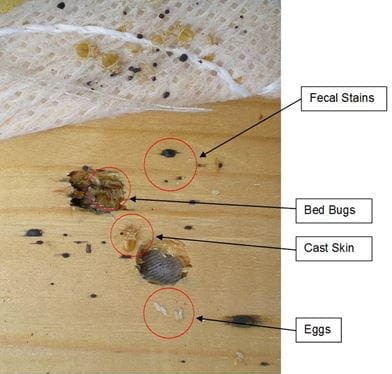Here’s everything to know about the link between bedbugs and travel.
Bedbugs are small, flat insects that feed on the blood of people and animals while they sleep. The French government has had to work to calm a nation as people raise concerns about a bedbug crisis as the country prepares to host the Olympic Games in just nine months.
Videos on social media of tiny creatures appearing to burrow in the seat of a fast train and reports of cases of bedbugs on public transport have proven to be unfounded, according to the transport minister.
But bedbugs have been a problem for decades. The bugs are very good at hiding and their slim, flat bodies allow them to fit in tiny spaces and stay there for long periods of time. They can go without feeding for between 20 to 400 days depending on temperature and humidity, according to studies.
Bedbugs are not a sign of a dirty home or poor personal hygiene. Bedbugs travel to new places by hiding in furniture, suitcases or other objects that get moved around. They are not known to spread disease but can be annoying because they can cause itching and loss of sleep.
---> Read more: Bedbugs are making France anxious ahead of the 2024 Summer Olympics
The life cycle of a bed bug

Adults and all nymphal stages of bedbugs need to feed on blood from warm-blooded hosts. They prefer humans, but can use other mammals and birds when humans aren’t around.
Females lay about five eggs daily throughout their adult lives in places such as mattress seams, crevices in box springs, spaces under baseboards, and more. The eggs hatch in about 4-12 days into first instar nymphs, which must feed on blood before molting to the next stage.
The bugs will undergo five nymphal stages, each one requiring they feed on blood before they molt to the next stage. After the sixth stage, they molt into an adult.
Nymphs resemble smaller versions of adults. Nymphs and adults take about five to 10 minutes to obtain a full blood meal. The adults may take several blood meals over several weeks.
Mating takes place off the host and involves “traumatic insemination” whereby the male penetrates the female’s abdominal wall with his external genitalia and inseminates into her body cavity. Adults live six to 12 months and can survive for long periods of time without feeding.
How to check for bedbugs

Signs of a bed bug infestation include finding small wingless bugs in cracks and crevices around the bed, seeing small blood spots or bed bug fecal matter on bedding or finding bed bug eggs or cast skins.
Many people who have been bitten by a bed bug will see itchy welts, similar to a mosquito bite. Bite reactions vary from person to person and some people do not react at all. Bed bug bites have not been found to spread any diseases.
The only way to know for sure if you have bedbugs is to find a live bed bug in your home. You cannot tell just by looking at the bites. If you suspect you have bedbugs, you should inspect your bed or sleeping area. You can also contact a pest management professional to do an inspection for you.
The bite marks usually appear on the face, neck, arms, hands or other body parts and people are bitten while sleeping. The bites may take as long as 14 days to develop in some people, so you should look for other clues.
When a bed bug bites, it injects an anesthetic and an anticoagulant that prevents a person from knowing that they have been bitten. The bite marks may be random or appear in a straight line. Other symptoms include insomnia, anxiety and skin problems. You should avoid scratching the bite area and apply antiseptic creams or lotions and take an antihistamine.
The signs of a bed bug infestation include the bedbugs’ exoskeletons after molting, bedbugs in the fold of mattresses and sheets, rusty–colored blood spots due to their blood-filled fecal material that they excrete on the mattress or nearby furniture, and a sweet musty odor.
Not all bugs you find in your bedroom are bedbugs, you should contact a professional to be sure.
Do bedbugs spread disease?
No. Bedbugs are not known to spread disease.
Can you prevent a bed bug infestation?
You can take steps when you’re traveling or purchasing secondhand furniture to help prevent a bed bug infestation.
Officials said you should avoid picking up used mattresses or secondhand upholstered furniture because it’s hard to see if they have bedbugs in them. Other used furniture should be carefully inspected and cleaned before you bring it home.
You should scrub the furniture with soapy water or a household cleaning product to remove any bedbugs or their eggs. Second-hand clothing should be placed in a sealed, plastic bag and emptied directly into the washing machine. Wash the clothes in hot water and dry them on a high heat setting to kill bedbugs and their eggs.
When you’re visiting hotels you should inspect the room for signs of bedbugs before you unpack your luggage.

How to treat a bed bug infestation?
Taking care of a bed bug infestation is not easy.
You need to act quickly, and will likely need to call an experienced pest management professional. The professional will use several methods, either separately or in combination, to kill the bedbugs.
Bug bombs are not effective at killing bedbugs. Many “all-natural” sprays are also not effective at controlling bed beds. Officials do not recommend using rubbing alcohol to treat a home for bedbugs, it’s not very effective but it is very flammable.
More information on how to treat a bed bug infestation is available in the PDF below. (Can’t see it the PDF? Click here.)
More resources from the Michigan Department of Health and Human Services:



